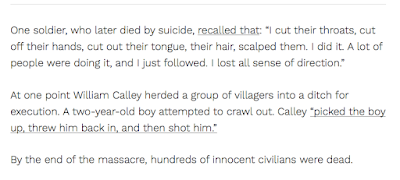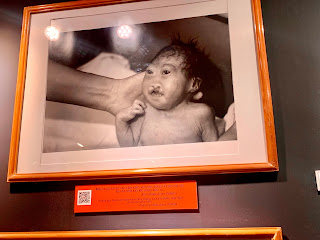27th Dec 2022
 |
| 2nd Lieutenant William Calley |
In all wars there have been acts of barbaric inhumanity. The German army which massacred whole French village populations as reprisals towards the end of WW2 springs to mind. The Vietnam War (or The Great American Fuck-Up, as I have coined it) was no exception. The difference being that by the 1960s/70s there were many more reporters around with cameras and good communications to report the goings on.
One prime example, and there were others, was the My Lai massacre on March 16th 1968. On this occasion a platoon of US Infantry were tasked (what their orders were is not clear, presumably to 'flush-out' VC) to go into the small hamlet of My Lai which is situated near the coast on the east side of the Central Highlands. The Platoon Commander, 2nd Lieutenant William Calley, of Ist Platoon, C Company, 1st Battalion, 20 Infantry Brigade, unopposed on entering the village, gave orders to round up all the villagers. They were nearly all old men, women and children. The young men had had the sense to disappear leaving their families whom they thought would be safe; some too old or small to escape anyway. Calley instructed his soldiers to 'deal' with the groups of rounded-up villagers after going through the village burning houses, shooting animals and destroying property and, by all account, his soldiers raped some of the women. Under Calley's orders he, and his men, proceeded to shoot, machine guns blazing, all these helpless villagers. About 400 (estimates vary) were killed, all old men, women, children, babies (some of the bodies in the photo above). There were no VC found in the village.
This unspeakably murderous, gratuitous and senseless massacre was more or less 'covered-up' by the military hierarchy at the time. One of the misguided aspects of this war was that the US Army was encouraged to record and report a 'body count' after operations to satisfy the Top Brass that the VC were being beaten. Sadly, they didn't care which bodies were counted...the more the better and commanders' reputations were enhanced by the numbers! The photo was taken by an army cameraman soon after and was eventually published and thus came to the attention of the US public.
Calley was Court Martialled in 1970 and sentenced to life imprisonment for murder. However, President Nixon (in his wisdom) and due to public opinion believe it or not, commuted the sentence to 3 years of 'fairly open' house arrest in his quarters at Fort Benning and he was officially released in 1974. By all accounts he had been a very second-rate officer who had only just scraped through his officer training course at a time when the US Army was desperate for recruits.
After his release Calley got married and worked at a jewellery shop owned by his father-in-law in Columbus, Georgia. He then divorced and moved to live in Gainsborough, Florida where, as far as I can gather, aged 79, he still is. According to some reports he is unrepentant. This photo (right) is of him taken in 2018. This murderous, and probably stupid, man should not have been sentenced to prison. He should have been hung, drawn and quartered. I think if I ever had the misfortune to meet him, or him me, I would be tempted to shoot him! Actually I would probably be tempted to stab his eyes out, cut his balls off and watch him bleed to death!
BOMBS. The US were very fond of using them and saw them, mistakenly as it turned out, to be the answer to this (and other) military situations. They were dropped from many types of aircraft including enormous payloads from large fleets of 'carpet bombing' B52 bombers. High Explosive (of varying type and sophistication), Cluster bombs, phosphorous and Napalm were part of the arsenal.
Right: Can Thi Lac and her children who were all killed in a B-52 'carpet bombing' raid on and around the village of Kiem Hung in 1972. It is amazing the number of innocent civilians who were killed or maimed in this war, whereas the 'armed enemy' were usually able to avoid being hit by the simple expedient of leaving the villages and taking shelter in the countryside.
They were very keen on using napalm (an incendiary device consisting of enhanced petrochemicals which had a gell like property which burnt and stuck to things, like people. Left: A famous photo of villagers running from a village near the town of Tay Ninh (west of Saigon) after a napalm attack. It was titled 'Napalm Girl' featuring a screaming 9 yr old girl called Pham Thi Kim Phuc who had been badly burnt. The photographer was Huynh Cong Ut (Nick Ut) and it won several Press Photo awards.
They also used the controversial liquid 'defoliant' Agent Orange (containing the poison dioxin) to clear the jungle canopy with the hope of uncovering the VNA/VC hidden beneath, as on the Ho Chi Minh trails. This stuff certainly defoliated, but also had seriously poisonous 'genetic' effects on anyone who came into contact with it. It resulted in subsequent hideous birth defects and diseases of many kinds which are still being passed on in the population today.
The companies which made the filthy stuff have been under litigation for some time. They have, indeed, compensated US personnel affected (I believe), but no such compensation has been offered to the Vietnamese. To do so would admit responsibility, which the US is keen to avoid. There are many disfigured Vietnamese who also develope cancers and it is all still genetically passed on.
Right: General Vo Nguyen Giap giving orders to his commanders. He was the Commander-in-Chief of the 'Peoples Army of Vietnam' (North Vietnam Army) and a very talented stategist; reckoned to be one of the world's most successful. He certainly saw off the French and Americans/South Vietnam forces. He was later a successful and much admired politician: A national hero, he died in 2013 aged 102.
While on the subject of gruesome photos, there were some particularly nasty jails run by the South Vietnamese during this conflict. There were eight of them; two of them on small islands, Phu Quoc and Con Dao, which are now splendid holiday resorts. They had the reputation of torturing and killing inmates who were mostly VC suspects or collaborators. There is an exhibition concerning these jails in Saigon and many photos displayed of appalling tortures and executions. There are photographs of prisoners being buried alive, crushed between planks and garrotted etc. The photo above shows the end result of some of these.
I must say that this conflict was a very nasty affair. It was something that with a bit of thought, you would think, after the French experience, that the US would not have ventured into. It was all down to their paranoid fear of communism spreading south. They certainly left in a hurry, in 1975, with their tails between their legs when the VNA rolled into Saigon. It was a highly unpopular war with the public in the USA, and other places across the world, with many well recorded and sometimes violent demos against it. The strategy, if not tactics, of the US forces was, in many cases, very poor. Yes, they had an overwhelming technical advantage with weaponry and aircraft etc., with some good troops and won many local battles, but failed to understand that you are onto a loser, eventually, if the majority of a large country is against you, and they are zealously nationalistic and determined and tough and enterprising, when many your soldiers are conscripts with little empathy with or understanding of the locals and with dubious morale. I think there were many US politicians that seriously regretted their venture into Vietnam. At least the French, despite being unpopular and with some fairly brutal treatment of the Vietnamese 'nationalists', left behind much beautiful architecture, infrastructure such as a railway system and roads, water reservoirs and suchlike. All the Americans left behind, as is their wont, were bomb craters, bullet holes and bodies.
I wonder if a similar scenario will play out in Ukraine?













A very descriptive and fair assessment of a truly dreadful war ( all wars are dreadful) but this remains in my memory as the family watched the black and white TV which was only on for the News , and I distinctly remember the collective family despair at the words every night " continued fighting in the Mekong Delta" - I visited the museum, and the Cui Chi tunnels where the American sounding Guide told us of the "horrific man traps " made by the Viet Cong , and actually blushed when I asked what the enormous crater to the right was . A B52 crater about 50 m in diameter ! Nuff said. Respect to the Vietnamese - and their ability to avoid animosity and retribution. My Lai was horrific.
ReplyDeleteI made the rather fatal error of returning to the homeland for 2 wet weeks. Almost every household I visited had Covid or a stinking cold, I alone remained well, protected by my homeopathic prophylactic .A very quiet time and rather sad time. ....but lovely to see old friends, especially when they were out of bed! Next year - its India or Vietnam! or Nicaragua!
As long as the deadly Moneypox doesn't raise it ugly head.... or some other deadly disease .
Time for you to come to Slovenia ..